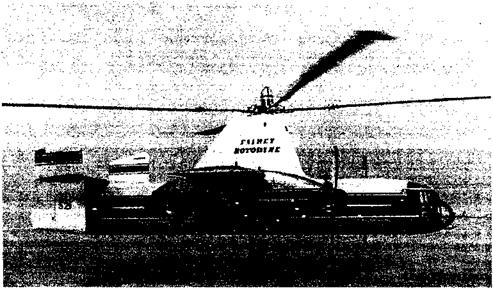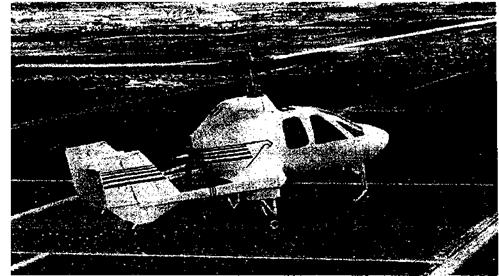Renaissance of the Autogiro?
In the 1950s, there was some revival of interest in the gyroplane and convertiplane or gyrodyne concepts, with a series of prototypes being designed by the Fairey Company in Britain and McDonnell in the United States. These machines were designed to help overcome the inherent forward flight speed limitations of a conventional helicopter by offloading the rotor with a conventional fixed-wing, and so reducing rotor thrust and the high inherent drag of the rotor in forward flight. Gyroplanes can takeoff vertically and hover with the rotor powered, for instance, by tip jets, but the rotor is then off-loaded (for the most part) by a conventional wing in forward flight. When the shaft torque is removed from the rotor, it can be made to enter into the autorotative state by With the assistance of tip-jet pioneer Friedrich von Doblhoff, McDonnell developed the XV-1 [see Hickey (1956) and Harris (2003)] but its performance was disappointing. Two Fairey Gyrodyne prototypes
le. d to the. Rntorlvne. which was the wnrld’s hitrocsf avrnnlanp with я с. я-hin hio cnrmoh fnr
—- – ‘-j -? .. " “ v‘oo’,v/v О О
40 passengers – see Fig. 12.17. The program has been discussed by Hislop (1958) and
|
Figure 12.17 The Fairey Rotodyne was the world’s biggest gyroplane but it did not go into production. Source: Photo courtesy of Agusta-Westland. |
McKenzie (1959). For takeoff and landing the rotor was driven by tip jets. The aircraft was a technical success and set a world speed record for a convertiplane in 1959 before the project was cancelled – see Boulet (1984) for a detailed discussion.
During the late 1950s and early 1960s, small commercial autogiros were developed in North America for the private aviation market by three companies: Umbaugh (later known as Air & Space), Avian, and McCulloch. While Umbaugh and McCulloch delivered over 100 machines, these had limited performance and the lack of sustained orders put the companies out of business. Single and two-seat autogiros were also built in Britain – see Wallis (1963). In the 1950s, Igor Bensen developed a homebuilt autogiro with an open airframe, based to some extent on the simplicity of the German Fa-330 “Kite” and Hafner “Rotachute.” A thriving amateur homebuilt autogiro market is still active today, many of these designs stemming from the Bensen designs. As of 2005, there were at least a dozen manufacturers in business catering to the homebuilt market – see the Popular Rotorcraft Association’s web site (2005), http://www. pra. org.
From a scientific perspective, there have been few recent studies of autogiros. However, work by Houston and colleagues (1998a, 1998b, 2000, 2001) has begun to reexamine the stability, control, and handling qualities of autogiros, mainly from a flight safety and certification standpoint. Advanced mathematical models of the autogiro were developed and validated by flight test measurements conducted on a specially instrumented two-seater autogiro. This work represents the first significant scientific interest in autogiros in over five decades and perhaps points the way forward toward improved future autogiro and gyroplane designs. While the autogiro led the development of the helicopter and there are clearly many similarities between the autogiro and the helicopter, it is perhaps ironic that fifty years hence the confidence levels in the design of a new autogiro are lower than for a new helicopter.
Recently, two companies in the United States have resurrected the idea of the autogiro or gyroplane and have begun to exploit its capabilities using modem technologies. These companies are Carter Aviation Technologies and Groen Bothers Aviation (GBA), Inc. The Carter test platform incorporates both a rotor and a large, relatively high aspect ratio fixed – wing. It is a hybrid aircraft using some of the underlying principles of the compound or convertiplane machines of the 1950s. While the rotor provides nearly all of the lift during takeoff and landing, the wing produces most of the lift at higher airspeeds, with the rotor almost completely offloaded and operating in its autorotational state. The high inertia rotor has a bearingless hub, with a tilting spindle to control the orientation of the rotor disk (much like in the original Cierva designs) and collective pitch to control rotor rpm. The machine is made almost entirely of composite materials and is powered by a lightweight propeller driven by a reciprocating engine. Conventional flight control surfaces (ailerons, elevator, and rudder) are used, again much as on the original Cierva Autogiro designs.
Groen Bothers Aviation (GBA) have developed a turboshaft powered gyroplane called the Hawk 4 (Fig. 12.18). The GBA machine provides all of the short takeoff and nearly vertical landing capabilities of the helicopter, with a demonstrated level flight speed of 148 mph (238 kph). Among other innovations, the two-bladed articulated rotor incorporates a cone-pitch coupling for improved rotor rpm stability. It uses a swashplate with collective and cyclic pitch, which gives the aircraft good maneuverability and also allows for short takeoffs. The all-metal blades use advanced airfoil sections that are designed specifically to meet the unique aerodynamic requirements of sustained autorotational flight. Unlike the Carter machine, there are no conventional flight control surfaces for roll or pitch, this all being achieved through rotor control, with rudder for directional (yaw) control.
|
Figure 12.18 Groen Bothers Aviation Hawk 4 is a modem turboshaft-powered gyroplane. Source: Photo courtesy of GBA. |













